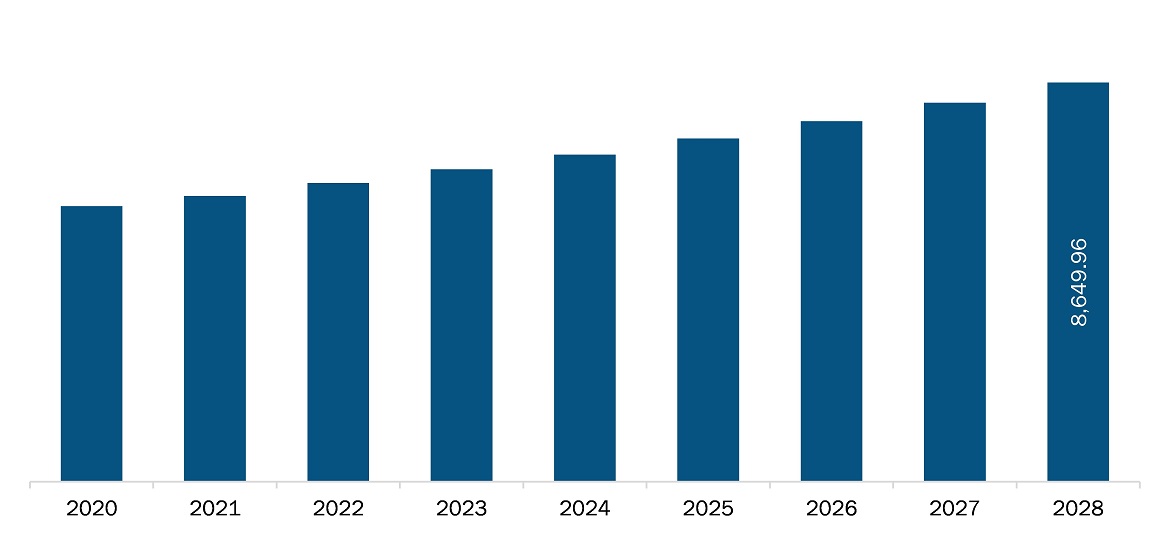The medical imaging market in Asia Pacific is expected to grow from US$ 6,192.7 million in 2021 to US$ 8,650.0 million by 2028; it is estimated to grow at a CAGR of 4.9% from 2021 to 2028.
Big data analytics is revolutionizing healthcare in general, so it is no surprise that there is much to look forward to in the future of analytics in medical imaging. For example, analytics are often used to detect patterns specific to a certain pathology. Imaging algorithms can derive metrics using intensive analysis of these patterns in a digital image, and then deliver scores that complement any analyses made by the radiologist, resulting in quicker, customized, and accurate diagnoses. In an article on ITN, Dhaval Shah and Prashanth Kollaikal of CitiusTech discussed the promising potential of big data in diagnostic imaging. “We can look forward to new and interesting features in the radiology information system (RIS) and PACS systems, especially those in the cloud, which might include analytics and impressive reports on operational and clinical data,” states Shah. Enterprise-wide key performance indicators (KPIs) derive from a variety of existing sources. Then, these KPIs are used to suit the needs of the provider, taking clinical efficiency, operational efficiency, and patient comfort into consideration. Even though these KPIs have been used for optimization for many years now, overall efficiency can be easily measured and greatly improved with the technological aptitude of devices, increased modalities, advanced software systems, and mobile devices.
The COVID-19 pandemic has critically impacted the region, but it has also provided an opportunity for stakeholders to realign their future path based on strategic intent and focus. Moreover, various economies have been intensively making the use of medical imaging devices to diagnose, assess, monitor, and plan the treatment of patients suffering with the COVID-19. According to the World Health Organization (WHO), Imaging has been also considered to complement clinical evaluation and laboratory parameters in the management of patients already diagnosed with COVID-19 among various countries such as India, Pakistan, Japan, and others in the region. The use of medical imaging on symptomatic patients for monitoring their treatment progress required high number of these systems to perform procedures. Thus, increasing government support and reimbursement policies for medical devices are expected to support the medical imaging market. The COVID-19 pandemic has a positive impact on the Asia Pacific Medical Imaging market in the countries in the region.
With the new features and technologies, vendors can attract new customers and expand their footprints in emerging markets. This factor is likely to drive the medical imaging market. The Asia Pacific medical imaging market is expected to grow at a good CAGR during the forecast period.

- This FREE sample will include data analysis, ranging from market trends to estimates and forecasts.
Asia Pacific Medical Imaging Market Segmentation
By Product
- CT Systems
- X-ray Systems
- PET Systems
- MRI systems
- Ultrasound Systems
- Others
By End User
- Hospitals
- OP Centres
- Clinicians Offices
- Emergency Care Centres
By Country
-
Asia Pacific
- China
- Japan
- India
- South Korea
- Australia
- Rest of Asia Pacific
Companies Mentioned
- General Electric Company
- Siemens AG
- Koninklijke Philips N.V.
- Shimadzu Corporation
- Hitachi, Ltd.
- Canon Inc.
- Hologic, Inc.
- Carestream Health Inc.
- ESAOTE SPA
- Samsung Group
Asia Pacific Medical Imaging Report Scope
| Report Attribute | Details |
|---|---|
| Market size in 2021 | US$ 6,192.7 Million |
| Market Size by 2028 | US$ 8,650.0 Million |
| CAGR (2021 - 2028) | 4.9% |
| Historical Data | 2019-2020 |
| Forecast period | 2022-2028 |
| Segments Covered |
By Product
|
| Regions and Countries Covered |
Asia-Pacific
|
| Market leaders and key company profiles |
|
- Historical Analysis (2 Years), Base Year, Forecast (7 Years) with CAGR
- PEST and SWOT Analysis
- Market Size Value / Volume - Regional, Country
- Industry and Competitive Landscape
- Excel Dataset
Recent Reports
Testimonials
Reason to Buy
- Informed Decision-Making
- Understanding Market Dynamics
- Competitive Analysis
- Identifying Emerging Markets
- Customer Insights
- Market Forecasts
- Risk Mitigation
- Boosting Operational Efficiency
- Strategic Planning
- Investment Justification
- Tracking Industry Innovations
- Aligning with Regulatory Trends






















 Get Free Sample For
Get Free Sample For